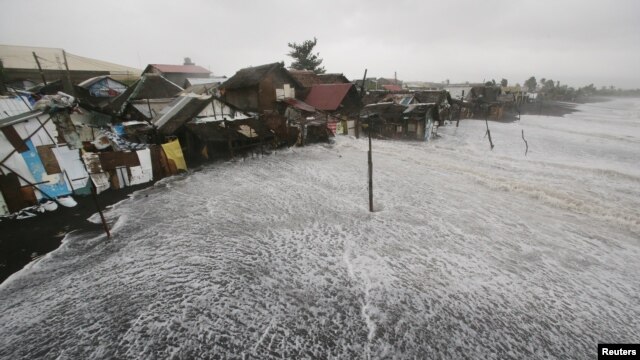
Strong waves crash into coastal houses as Typhoon Hagupit pounds Legazpi, Albay province, eastern Philippines, Dec. 7, 2014.
MANILA—
Typhoon Hagupit caused flooding, high waves, and knocked out power as it made its way across the central Philippines Sunday.
At least two people in central Iloilo province have died due to the typhoon, disaster-response agency chief Alexander Pama said.
However, some storm-weary evacuees who were hit hard by a highly destructive cyclone last year were able to return home after Typhoon Hagupit passed their area.
The Philippine Red Cross said it continues to monitor Typhoon Hagupit, downgraded from a Category 5 storm to a Category 2, as it tracks on a northwesterly course. State forecasters expect it to make landfall on several more islands.
Surveying storm damage
Red Cross Secretary-General Gwendolyn Pang said rapid assessment teams are doing initial surveys of areas that the storm has left. She said they have not been able to get to a few of the towns that Hagupit first struck.
“So far we have not received major reports like casualties or major damages. And these are all manageable at this point in time, although our greatest concern is there are still areas we cannot reach and contact,” Pang said.
But, overall, Pang said the initial reports, which do not show casualties, mean the mass evacuation efforts may have been effective.
The Red Cross said 1.2 million residents went to evacuation centers.
Pang said with the memory of killer storm surges from last year’s Super Typhoon Haiyan fresh in people’s minds, it took little convincing to get residents to safe ground.
The Civil Defense Office said the main priority now is clearing operations.
Defense officials said some roads are blocked by fallen trees, “voluminous debris” and flooding.
Military Chief Gregorio Catapang said once entry points to an airstrip and airport in Eastern Samar province are cleared they can be used as backup landing points for military craft delivering relief goods.
Catapang said 11 countries, including the United States, China and Japan, are part of a multinational humanitarian and disaster relief team that is ready to help with distribution.
Last year, Haiyan’s 230 kph winds left impenetrable debris fields that left residents without access to food and water for days.
City officials in Tacloban, where the brunt of Haiyan’s 7,300 deaths occurred, said some evacuees were actually heading back home Sunday.
Early enforcements
Tacloban Social Welfare Director Gloria Fabrigas said the city gave strict orders ahead of the storm to try to keep the city accessible after the storm hit.
“They evacuated early and we enforced liquor bans. We enforced no cars in the streets, in the main streets especially. So it’s very clean, it’s easy. And there are no damages except some wires that have fallen. As of now we don’t have electricity,” Fabrigas said.
Power was out in dozens of towns and cities in at least eight provinces. There was also widespread flooding in the affected areas.
Fabrigas said there were reports that some of Tacloban's temporary shelters, which were being used to house about 14,000 residents who had lost their homes during Haiyan, were damaged.
The Red Cross’s Pang said teams were also checking on the status of the housing units the agency had built for survivors of last year’s typhoon.
The head of the Catholic Relief Services office in Tacloban said initial reports showed minimal damage to a handful of the homes in their “build back better” housing projects. |
|
